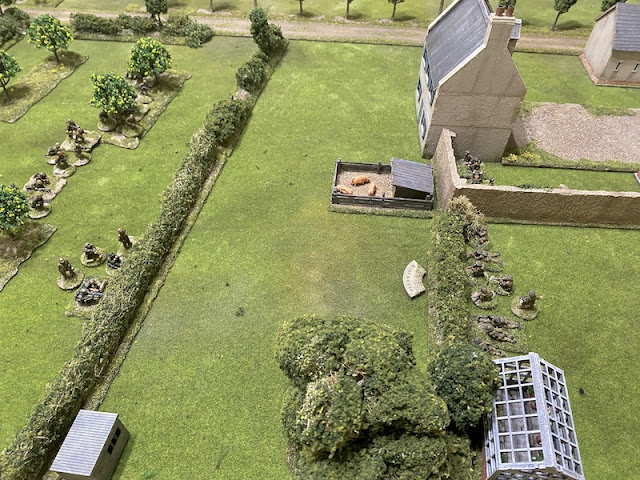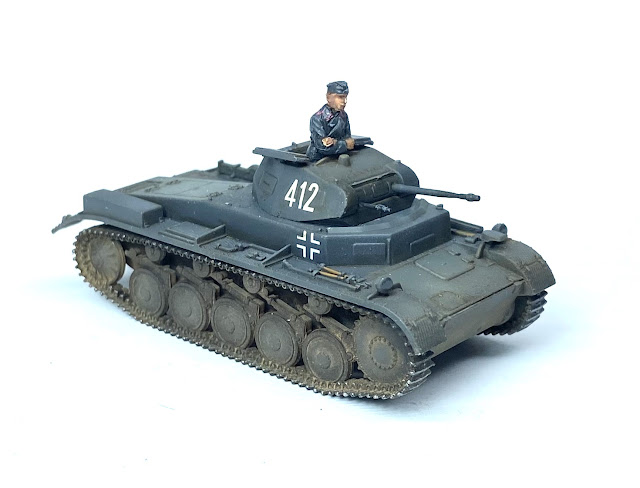Having driven the British off in
the previous game the Germans now mount a local counterattack that brings us back to St Nicholas Farm. At the very least this will allow the Germans to impose further delay on the British. At best they could push them back to Fontenay village, which would put an end to any prospects of an outright campaign victory.
My initial thoughts are this could well be a short game. I doubt Dave will want to risk many casualties to his core platoon and so I'm expecting a limited spoiling attack that seeks to delay the British, but no more. He can't call on any further infantry as support and so I envisage this carried out by German armour. That said, I can't risk any complacency. He could have a Panther and so I'll want to ensure my platoon is well supported by anti-tank weapons.
The Germans patrol phase opens with two free moves and they concentrate all their efforts on gaining jump-off-points in the orchards. The British cover the farm buildings, but also the right flank. The threat of an anti-tank gun from that direction will mean German armour will need to avoid any rash moves down the road. The Germans have twelve support points, allowing enough for a Panther or even a couple of PzIV.
The British platoon from the Royal Scots Fusiliers has suffered a number of casualties and is short eight men.
The British have twenty one support points and I could call on additional support to boost my infantry strength. However, I'm more concerned I'll need to beat off an attack with armour so instead I'll call on a Sherman, a Sherman Firefly, a 17 pounder anti-tank gun and an additional PIAT team.
I'm fairly confident that equips me to handle any German armour. The same combination of supports served me well when faced with
the earlier counter attack from the Panthers of the 1st battalion of Max Wunsche's 12th SS Panzer Regiment.
We both start with force morale at nine and the British have the initiative.
With German jump-off-points in the orchards I'm keen to establish a defensive firing line and a section deploys behind the hedgerow to the left of the farm buildings.
The section corporal puts both teams on overwatch. From there they can cover any move by the Germans to the hedgerow opposite.
A Sherman arrives to the left of the road behind the farm. I want to bring that into a position to provide fire support for the defending infantry.
In the German phase an MG42 MMG team deploys into the orchard.
They arrive with a senior leader who has been called in for additional support. He puts the team on overwatch.
This tells me a few things. The Germans won't have a Panther in support, the extra senior leader and the MMG team have used up six of their support points. So I wonder, is this going to be an all infantry attack? Possibly, although the remaining support points may have been used for a PzIV, so it's not yet clear what Dave has planned.
In the British phase the Sherman makes its way forward very slowly.
The platoon's 2” mortar team deploy into the farmyard behind one of the high walls. If the Germans have any unwelcome surprises a few rounds of smoke from the mortar might come in useful.
The German build up continues and two squads deploy into the orchard and take up tactical positions.
My assumptions that Dave would not risk casualties to his core platoon may appear unfounded.
The Sherman moves forward cautiously and positions itself at the edge of a small orchard behind the farm.
The following German command roll is 66443 and a double phase. While I'm pleased I have a section on overwatch at the hedgerow ready to respond to any German advance what I haven't factored on is the appearance of a Pak40 anti-tank gun in the orchard.
It's within 6" of the edge and so has a line of sight out and over the hedgerows to the Sherman. It's a partially obscured target but the Pak40 commander has laid the gun well.
The 75mm AP round slams into the Sherman inflicting eight AP strikes. There's no way the tank's armour can cope with that and the Sherman explodes in flames.
I make the worst possible rolls for the loss of the tank commander and the tank itself and British force morale tumbles from nine to five in one fell swoop. That's a disaster in more ways than one. I've equipped my platoon to deal with enemy armour and it's clear I'll be facing an infantry assault for which my weakened platoon is now ill prepared. The game has only just begun but it's clear I'm in a bit of trouble.
The recently arrived oberscharführer (senior leader) orders the nearest squad to move through the orchard towards the hedgerow.
They move a little slower than he would like.
When he orders the second squad to also move towards the hedgerow he's equally disappointed to see they move no further than the first squad.
He then orders the MMG team to advance with him and, unlike the two squads, they cover the distance quickly.
That puts them right in the sights of the waiting British section who have been placed on overwatch for just such an eventuality.
They open fire immediately.
The intitial burst of fire is deadly, killing two of the MMG team and inflicting two points of shock.
The Germans have the next phase and a roll of 66652 means the momentum will stay with them. For this phase there are not many command options and one of the squads makes its way forward to the hedgerow to join the MMG team.
In the subsequent German phase the second squad moves up to the hedgerow. They join the squad and MMG team to create a powerful and daunting firing line.
The squad already at the hedge returns fire at the British section opposite.
Despite the high volume of fire there are no casualties but the section suffers five points of shock.
Premature as it might seem I can already feel this game slipping away from me. I see no point engaging in a firefight with the Germans in the orchard. Even if I deploy into the farmhouse I doubt the advantage of hard cover will even up the odds.
I need to bring what firepower I can to bear and so deploy the 17 pounder on the flank. It has reasonable high explosive rounds and may be able to inflict casualties from a distance.
Despite a few hits it only manages to inflict a couple of points of shock on one of the panzer grenadier teams.
I see little to be gained by having the lone section hold the hedgerow. The alternative is to reinforce the firing line by deploying into the farmhouse, but that seems very unwise. For one thing it would allow the Germans to concentrate all their fire on the section in light cover at the hedgerow. That's potentially over fifty fire dice! On average results I could expect four dead and eight shock, which would effectively sweep away that section in a single fire phase. Not a good idea.
The section corporal rallies off a point of shock.
He then orders them to withdraw to the farm. They waste no time and fall back quickly.
The German platoon makes no move in their phase, instead they focus all their firepower on the 17 pounder crew.
It may be at effective range but the combination of four MG42s generates an awful lot of firepower.
The crew are struck by a hail of gunfire. Three are killed and the gun commander is lightly wounded. They also suffer four points of shock, which is enough to see the crew pinned down.
I can't seem to roll less than a six for checks on force morale and so the wounding of the gun commander sees British morale slump to three. Things are really not going well and it's not helped with the removal of the jump-off-point near the farmhouse.
Meanwhile the Pak40 crew manhandle their gun to the hedgerow.
Last the MMG team also target the 17 pounder crew.
Yet again the German fire proves deadly. Another member of the crew is killed and a further point of shock which is enough to see the remaining men break. They withdraw and move so fast that they leave the table. The breaking of a support unit and the sight of a junior leader routing from the table is sufficient to drop British morale to one.

By now I think it's abundantly clear how this is going to end. With the arrival of the British phase I announce a withdrawal and begrudgingly cede this map to the Germans. The lost jump-off-point means the 2” mortar team have trouble withdrawing and one of the men is dispersed and will miss the next game.
What a setback for the campaign, the more so for being so unexpected. The Germans made a well conceived infantry assault that took me by surprise. It certainly didn't help that British force morale fell so rapidly, but the real issue lay with my choice of supports for this engagement.
Naturally, with the benefit of hindsight, I could consider what may have been done differently. Certainly a forward observer directing a 3" mortar barrage could have put an immediate stop to the German infantry, but would it have been enough to stop armour had it arrived?
It's comes as no surprise to learn that Dave intends to continue counterattacking while he holds the initiative. It makes perfect sense as it puts the Germans very much in control of the campaign. The clock is ticking against the British and the best they can hope for now is a draw, which assumes they win the next three games. It was all looking so optimistic only two games ago, how the worm has turned!
So the British will retrace their steps and we will return to Fontenay village for the next game. You can read what happens next in
this post.
If you've enjoyed following along and would like to
Buy Me a Coffee to help cover some of the costs of running the blog you can click through at the link or on the tab in the right hand column of this page.






















































































